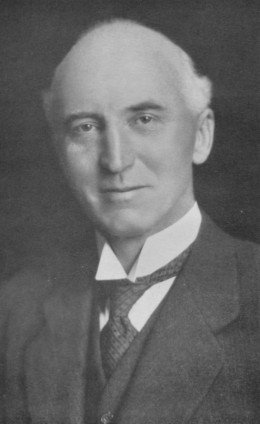
Edward Winter

‘His pleasures were essentially middle-class – golf, chess, dancing, theatre and, like Samuel Hoare, skating.’
The above quotation comes from pages 326-327 of Simon by David Dutton (London, 1992). Almost wholly forgotten today as a politician (and a fortiori as a chess enthusiast), Sir John Simon (1873-1954) was a brilliant lawyer who, between 1913 and 1945, held, with the exception of the premiership, all the major political offices in Great Britain: Attorney General (1913-15), Home Secretary (1915 and 1935-37), Foreign Secretary (1931-35), Chancellor of the Exchequer (1937-40) and Lord Chancellor (1940-45). A Liberal, he first served under Asquith, but it was in the 1930s that he was at the height of his renown. In March 1935 he went to Berlin to negotiate with Hitler, and towards the end of that decade he was regarded as Neville Chamberlain’s right-hand man. With the advent of the Second World War, however, he faced fierce recriminations, on the grounds that he had failed both diplomatically and economically (i.e. as Foreign Secretary and Chancellor of the Exchequer) to prepare his country adequately against Nazi Germany. More generally, throughout his life Sir John Simon was accused of indecision, inaction, infidelity and insincerity, and nowadays his name is seen mostly in quotations books as the target of such alleged barbs as Lloyd George’s, ‘The Right Honourable gentleman has sat so long on the fence that the iron has entered his soul’. In 1940 he became Viscount Simon, under which name he published, not long before his death, his rather bland autobiography Retrospect (London, 1952). In all, he served under five Prime Ministers: Herbert Asquith, Ramsay MacDonald, Stanley Baldwin, Neville Chamberlain and Winston Churchill.
In common with the above-mentioned book by David Dutton, Retrospect focussed on politics, and very little about Sir John Simon’s interest in chess has ever been written. Below, therefore, we present an extensive account of his views on the game, as well as some specimens of his play. As will be seen, it was during his busiest political phase, the 1930s, that he was most prominent in chess circles, being regarded as the ideal dignitary for delivering a graceful speech at the opening of a chess tournament. (It is not recorded whether the line-up of boards and pieces ready for action ever prompted anybody to exclaim, ‘Arrays, Sir John’.)
Already in October 1923 he had obtained a draw against Alekhine in a simultaneous display in London. See, for instance, page 201 of Alexander Alekhine’s Chess Games, 1902-1946 by L. Skinner and R. Verhoeven and pages 482-483 of the November 1939 BCM. The game-score has not been found.
C.N. 2947 quoted from The Times (London), 26 November 1925, page 18:
‘The House of Commons Chess Circle played one of their few matches against outside teams in Committee Room No. 16 yesterday afternoon, with the Athenaeum Club for their opponents. The result was a win for the Circle by 5½ games to 2½, and that total would have been increased if Sir John Simon had not by inadvertence thrown away a position where the win was within his grasp.’
On 29 November 1926 he participated in a debate on ‘Chess and Other Hobbies’ at the Authors’ Club in London, with a speech entitled ‘The literary associations of chess’. Below, from C.N. 3552, is the full text, culled from pages 280-285 of his book Comments and Criticisms (London, 1930):
‘Facing this expert company, I feel rather like Mr Winkle when he was invited to exhibit his skill on skates, and I cannot be too grateful that the Authors’ Club does not require me, as the price of my entertainment, to play an exhibition game of chess. It is much safer to talk about it, and there is one aspect of chess very suitable to be considered by a meeting of the Authors’ Club – what is the place which chess occupies in literature? How far does the literature of our own tongue recognize the position that this entrancing pastime occupies among the entertainments of mankind?
Considering the antiquity of the game, considering the affection with which it has been regarded by so many remarkable persons, considering the claim commonly put forward by the most insignificant chessplayer who has just won a match that real skill in the game is – as in the case of Napoleon – proof of the command of military strategy of the highest order – considering all these things, it is very remarkable how comparatively small is the part which chess appears to take in the literature of our country. I am not talking about the large collection of books devoted to expounding the game – “books”, as Charles Lamb said, “which are no books” – but am rather considering how far the imaginative writers in prose or verse have found this occupation a suitable topic to introduce into their delightful works.
Shakespeare, of course, did introduce it. Indeed, the stage direction in The Tempest, where the scene opens with Miranda and Ferdinand engaged in a game of chess, is one of the very few Shakespearean stage directions that are not immediately and vitally connected with the action, though it explains the conversation which follows.
I doubt whether Shakespeare understood chess. At any rate, it is very unusual for two players in the course of their first encounter to address each other thus:
“Mir. – Sweet Lord, you play me false.
Fer. – No, my dearest dear, I would not for the world.”Now if Bacon played chess, and Shakespeare didn’t, what light would this throw on the Baconian controversy?
But it is rather remarkable that, on the whole, literature contains so few references to the game of chess. Of course, there is the famous instance with which the name of Lewis Carroll will ever be associated, although I have never been able to understand the moves in that particular game. But what opportunities have been missed by others! What a pity it is that one of our literary gentlemen has not made the game of chess as prominent in his romances as Surtees made the pastime of fox-hunting. Why is there no lyric which runs :
O mystic chess, half instinct and half grind!
And all a pleasure and a wild surprise.Why is it that no sonnet-writer has described his feelings on a particular occasion by confessing:
Then felt I like some critic of the game
When a new gambit swims into his ken.Then what a sad failure to make use of the proper opportunity is exhibited by the more emotional of our journalists. What could the Church Times do with the headlines, “Persistent Attack upon a Black Bishop”. What loyal fervour could the Morning Post work up by describing the “gracious act of her Majesty the Queen in defending an isolated pawn”. What a reputation might be made by the author of a new scenario for the film if the title was “A Knight’s Suicide” featuring Charlie-Muzio!
Yes, it is certainly remarkable that chess does not take a bigger place in literature, because it is a great game. It has associated with it as continuous and as remarkable a series of examples of a particular kind of skill as any game one can pick. Think of the Syracusan, Paolo Boi, who exhibited such accomplishment in chess that, finding no worthy opponent in his own country, he made a lengthy tour throughout Christendom, encountered and defeated the great Ruy López himself, and was patronized and rewarded for his prowess by King Sebastian of Portugal and by Catherine de Medici.
Think of that marvellous boy, the Chatterton of chess, Paul Morphy, of New Orleans, who from the age of ten showed amazing aptitude in the game, and won a first prize in a major tournament at New York at the age of 21 [sic]. He came to Europe 70 years ago, defeated the strongest players in London and Paris, returned to his own country, abandoned chess for the profession of advocacy in the law courts, was never heard of in his new occupation, and after only partially recovering from an attack of insanity, died miserably at the age of 47. What a warning to us all to stick to the job we do best!
But although chess is a most exhilarating and amusing occupation, there is a sense in which it is not a game at all. Mr Bonar Law – who always managed to find time to play a game of chess, without in the least failing in the discharge of his full duty to the State – was accustomed to describe chess as “a cold bath for the mind” – which, in these degenerate days, is a very useful stimulant. What is the relation between strategy and tactics in chess? What are the qualities of mind and temperament most necessary for the game? For the game of advocacy one wants a good digestion, a good temper, and a good clerk; and of these three the greatest is the good clerk. But in chess playing I have a suspicion that there is more of psychological influence than some people suppose.
There are people who beat you before the game begins by the confident way in which they arrange the pieces, by the authority with which they make a move, almost by the way they look out of the window or drum their fingers while they are waiting for you to play.
In nearly all games there is always an element of judgment and an element of execution. The game in which those two elements are most equally balanced, perhaps, is the game of croquet. But chess has the very odd quality that the executive element consists in nothing more than picking up a little wooden image and moving it, consistently with the rules of the game, to some other square. Chess, therefore, is a game in which the element of judgment is the overwhelming element from the first moment to the last. Though in chess, too, there is an element of luck. I mean that, for all but the greatest masters, the strength or weakness of our combination is not fully planned or appreciated in advance, and sometimes is much better (or worse) than we intended or expected. But there is no rule of chess that the winner must confess that he builded better than he knew.’
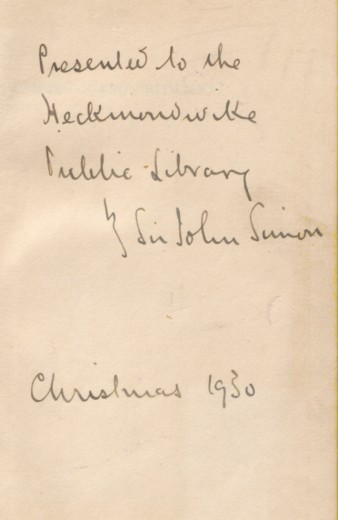
An inscription by Sir John Simon, in our copy of Comments and Criticisms
Another speech of his, to open a tournament in Cambridge, was reported on pages 189-190 of the May 1932 BCM:
‘It was a master stroke to secure the presence of Sir John Simon to open the Congress. The Foreign Secretary made one of the best speeches ever heard on an occasion like this. Fresh from his labours at Geneva his speech was both witty and topical. In the course of his remarks he said, “A congress which is going to be conducted on the principle that nobody speaks – (laughter) – and which is quite certain by the end of next week to have achieved some definite result which nobody will seek to deny or contradict, is a curiosity among international congresses. I shall take Cambridge as a very pleasant model of what a congress ought to be to places like Geneva or Lausanne. All of us who have tried to play chess spend much time in endeavouring to discover what exactly is the feature which distinguishes it from all other games. For politicians there is an obvious distinction, for chess is the only game which M.P.s are permitted openly to play within the precincts of the Palace of Westminster.”
There had been some quite considerable chessplayers among the members of the House of Commons; he would not say whether it was their political eminence which caused them to play chess well or their achievements in chess which endeared them to their constituents. (Laughter.)
“Bonar Law”, he remarked, “was a very good chessplayer indeed, and I remember, when I was a young man, seeing him fetched away at a critical moment of the game in the House of Commons to take part in a debate. I remember him returning two and a half hours later with the greatest coolness and making the move he had previously thought about for half an hour. I feel, therefore that we may describe chess as the politician’s game, for obviously there are some qualities which make it particularly suitable for politicians; for example, nobody can cheat in chess. So far as I know it is the only game in the world in which it is impossible to cheat.”
The speaker admitted that he himself had taken an interest in the game for a great many years, and it had been a great pleasure to follow some of the great matches in recent times. He was at Buenos Aires when the championship match was going on between Capablanca and Dr Alekhine.
“I gazed at the players through a plate-glass window, much in the way you would look at corpses in a morgue. (Laughter.) I watched for three-quarters of an hour, during which time Dr Alekhine made no move. Each man had the same pieces – a king, a castle and four pawns – and exactly at midnight Dr Alekhine made the move which I should have made in 30 seconds. (Laughter). The next morning the game was drawn by mutual consent.”
“What”, asked Sir John Simon, “are the qualities of this Royal, this ancient and this splendid game? What are the attributes you may hope to find inherent, or developed in the chessplayer? It is very difficult, indeed, to say. I doubt if there is any game in which it is more important to exhibit two essential qualities of sport – modesty when you think you are going to win, and determination when you think you are going to lose.”
He fancied that the attraction of chess for a great many people was that from the beginning to the end it was the discipline for all those moral qualities which lay at the bottom of all games. The fact that it was a game where no advantage was to be gained from lavish expenditure or special outfit, made it fundamentally one of the democratic games of the world.
He thought it was a fine thing that that worldwide game should be a pastime which might be pursued for the smallest possible outlay and without any paraphernalia; it made it one of the bonds of them all, whatever their circumstances. Then there was the fact that it required no ancient club to interpret its rules, which remain unchanged, and that it should be practised under the same regulations in every civilized country. It was those things which made it one of the most interesting games in the whole world.’
There was even a 24-line report on his speech on pages 137-138 of the May 1932 Deutsche Schachzeitung.
Concerning Sir John Simon’s reminiscences of attending the 1927 world championship match in Buenos Aires, Christian Sánchez suggested in C.N. 2554 that the game in question was the fifth (in which, however, Alekhine played Black). He pointed out that on page 58 of Match por el título mundial (published by Sopena, Argentina, 1978) it is stated that Alekhine reflected for 40 minutes on 41…Ra6, and that upon resumption of play the following day the game was drawn after disclosure of Capablanca’s sealed move (42 Kc3). We added in that C.N. item that page 4 of the Buenos Aires newspaper Crítica of 28 September 1927 reported that the time consumed by Alekhine over his 41st move was ‘almost three-quarters of an hour’. In C.N. 3070 Mr Sánchez reported that La Prensa of 13 September 1927 recorded that during their outward journey from Southampton to Buenos Aires on the British liner Alcantara Sir John Simon and J.L. Meikle, a member of the Liverpool Chess Club, played a game by radiotelegraphy against two anonymous passengers on the German steamboat Madrid. This consultation game began on 3 September in the middle of the Atlantic Ocean and concluded on 11 September with a win in 29 moves [sic – 39 moves, as shown below] for Sir John and Meikle. La Prensa mentioned that Meikle also planned to attend the Capablanca v Alekhine world championship match.
The game which Sir John Simon and J. Meikle played in consultation was published on pages 479-480 of the November 1927 BCM:
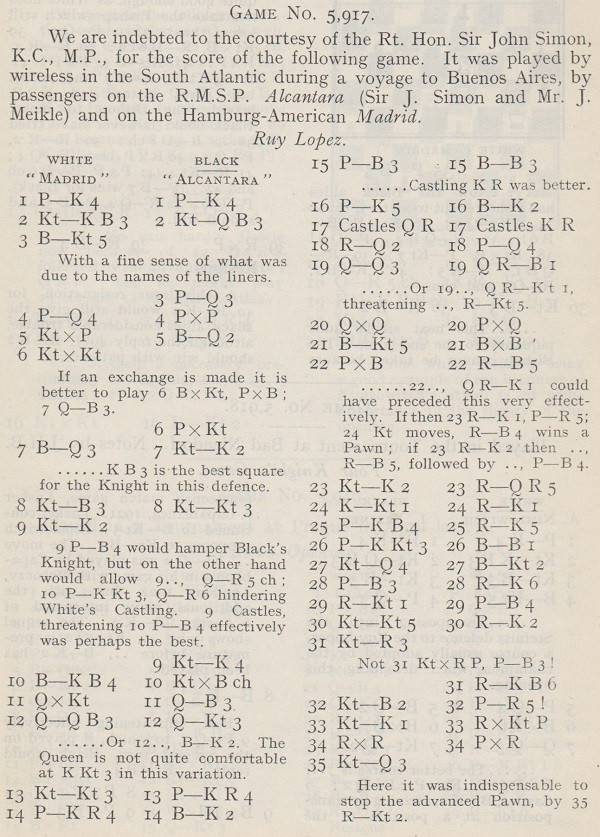
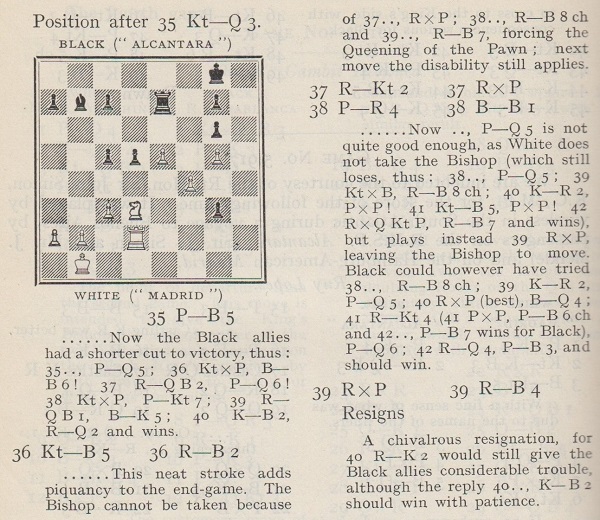
1 e4 e5 2 Nf3 Nc6 3 Bb5 d6 4 d4 exd4 5 Nxd4 Bd7 6 Nxc6 bxc6 7 Bd3 Ne7 8 Nc3 Ng6 9 Ne2 Ne5 10 Bf4 Nxd3+ 11 Qxd3 Qf6 12 Qc3 Qg6 13 Ng3 h5 14 h4 Be7 15 f3 Bf6 16 e5 Be7 17 O-O-O O-O 18 Rd2 d5 19 Qd3 Rac8 20 Qxg6 fxg6 21 Bg5 Bxg5 22 hxg5 Rf4 23 Ne2 Ra4 24 Kb1 Re8 25 f4 Re4 26 g3 Bc8 27 Nd4 Bb7 28 c3 Re3 29 Rg1 c5 30 Nb5 Re7 31 Na3 Rf3 32 Nc2 h4 33 Ne1 Rxg3 34 Rxg3 hxg3 35 Nd3 c4 36 Nc5 Rf7 37 Rg2 Rxf4 38 a4 Bc8 39 Rxg3 Rf5 40 White resigns.
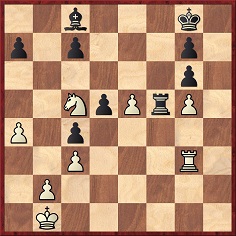
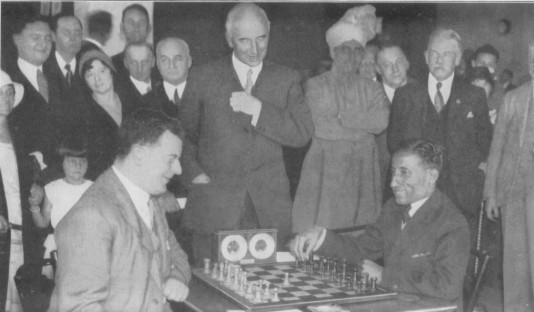
Sir John Simon (centre) at the start of London, 1932. T.H. Tylor has White against Sultan Khan
Sir John Simon also discoursed on the game when opening the 1932 British Chess Federation congress in London (BCM, September 1932, pages 369-370):
‘Sir John Simon said that, in view of the analogy between the Congress and other conferences, it came, he supposed, appropriately into the department of the Foreign Secretary. It was an advantage to have a congress which would attain a definite result, and one that was conducted in absolute silence. In looking through his small collection of chess books that morning, he came across one which he felt compelled to bring with him, The Game of Chess Analysed, by the great master Philidor in the eighteenth century, which claimed to show how “a perfect knowledge of this noble game may be acquired”! After quoting several extracts from the book, he said that chess was a fundamentally democratic game, requiring no great outfit – such as a set of clubs! – and contenting itself with the simplest materials. But it did demand the highest quality of sportsmanship, and an attitude of mind which made the game the thing, which took success with modesty, and accepted defeat with resolution.’
Further excerpts from the address were given on pages 485-486 of issue 32 of Les Cahiers de L’Echiquier Français, which concluded with the comment: ‘Shall we ever, in one of our meetings, hear a French minister pay such a fine tribute to chess?’

Sir John Simon on the front cover of Time, 21 March 1932
In 1933 Sir John took a board in a match between Cambridge University and eight Members of Parliament (an event won by the University +6 –0 =2), as was reported on page 172 of the April 1933 BCM. The score of his game, a loss, appeared on page 188 of the Times Literary Supplement, 16 March 1933:
Sir John Simon (House of Commons) – C.A. Coulson (Cambridge University)1 d4 Nf6 2 Nf3 e6 3 c4 b6 4 Nc3 Bb7 5 Bg5 Be7 6 e3 Ne4 7 Bxe7 Qxe7 8 Bd3 f5 9 Qc2 d5 10 Ne5 O-O 11 cxd5 exd5 12 O-O-O Nd7 13 f4 c5 14 dxc5 Nxe5 15 Nxe4 Nxd3+ 16 Rxd3 dxe4 17 Qc4+ Qf7 18 Rc3 Qxc4 19 Rxc4 bxc5 20 Rd1 Ba6 21 Rxc5 Rfc8 22 Rdd5 Rxc5+ 23 Rxc5 Rc8 24 Rxc8+ Bxc8 25 Kc2 Kf7 26 Kc3 Ke7 27 Kd4 Kd6 28 h3 h5 29 a3 Be6 30 b4 a6 31 Kc3 Kd5 32 Kb3 Bd7 33 Kc3 Ba4 34 Kb2 Kc4 35 Kc1 Kd3 36 White resigns.
Another game played the same year was published by André Chéron in the Journal de Genève of 12 May 1935, page 6:
Sir John Simon (Reform Club)–W.H. Williamson (Authors’
Club)
Hamilton-Russell Cup (Social Clubs), London, 1933
Albin Counter-Gambit
1 d4 d5 2 c4 e5 3 dxe5 d4 4 Nf3 Nc6 5 a3 Bg4 6 Nbd2 a5 7 Nb3 Bxf3 8 exf3 Nge7 9 f4 Ng6 10 Bd3 Be7 11 O-O O-O 12 Qc2 a4 13 Nd2 Nxf4 14 Bxh7+ Kh8 15 Be4 d3 16 Qd1 Ne2+ 17 Kh1 Nxe5 18 f4 Ng4 19 Rf3 f5 20 Bxd3 Qxd3

21 Qf1 Ne3 22 Rh3+ Kg8 23 Qf3 Bc5 24 Qh5 Nxf4 25 Qh7+ Kf7 26 Rg3 Rg8 27 b4 Qc2 28 h3 Qd1+ 29 Kh2 Bd4 30 Rb1 Rh8 31 Bb2 Qxd2 32 Rxg7+ Bxg7 33 Qxg7+ Ke6 34 Qe5+ Kd7 35 Qg7+ Kc6 36 b5+ Kd6 37 Be5+ Ke6 38 Qf6+ Kd7 Drawn.
Chéron noted that Black missed a clear win with 30…Ng4+.
Sir John’s speech at the 1937 Margate Easter Congress was reported on pages 233-234 of the May 1937 BCM:
‘Sir John Simon referred to chess as the most ancient and most universal game in the world. He was at Buenos Aires in 1927, when that great capital was all agog with the excitement of the world championship match between Señor Capablanca and Dr Alekhine. On a visit to Delhi as chairman of the Indian Commission he was invited to the home of a Punjab notable, and found an All-Indian chess tournament in progress there, with Mir Sultan Khan among the competitors. At the ancient monuments of the Moguls one saw laid out on the ground large black and white squares on which the Emperors played open-air chess with living pieces in an atmosphere second only to that of Margate (laughter). At chess congresses all paid their subscriptions and accepted the conclusions, which was not the case at most international conferences he had attended. Sir John thought it wonderful that this worldwide game existing through the centuries could be carried on by common understanding even between people who could not speak each other’s language. He referred also to the high standard of morality and honesty among chessplayers, though he made a jesting exception of the player who tossed for the move with two black pawns in his hands. He hoped that something new in chess in the shape of a “Margate variation” might arise from this congress.’
CHESS (14 April 1937, page 268) reported on the occasion at greater length:
‘Sir John Simon, Home Secretary, opened the Margate Congress with a speech whose wit and understanding of chess surpassed any we have previously heard. “Chess”, he said, “is not only the most ancient, but also the most universal game in the world.” People who had travelled extensively were often reminded of that fact surprisingly. He had come across chess congresses in places as far apart as Delhi and Boston. When Lady Simon and he were in South America a few years ago they found the town of Buenos Aires agog with excitement because of the Capablanca-Alekhine world’s championship then in progress there. “I looked at the board and said to myself: ‘White’s best move is so-and-so, but he should really agree to a draw.’ Alekhine thought steadily for 40 minutes, finally making the move I had expected. The game was carried over to the next day and the result was a draw in the end.”
Visiting India as a member of a Royal Commission, he was invited to the residence of a rajah. “When I arrived”, he stated, “the rajah’s polo ponies were lined up along the drive, his greyhounds and his hawkers with falcons on their wrists. A splendid scene. But inside the house a chess tournament was in progress, one of the contestants being Mir Sultan Khan, who became British champion soon after – and the thoughts of the rajah (it was plain to see) were all on that tournament.”
In India, he said, the ancient boards of the Moguls could be seen laid out on the ground, preserved through the centuries. Centuries ago the emperor used to play his chamberlain with living pieces and woe betide the foolish chamberlain who had not the good sense to lose!
He recalled the affection of the late Bonar Law for chess and his observation “I find chess acts like a cold bath to the mind!”
In conclusion, he recalled that he had opened many things in the course of his life, oysters, sardines, law-suits innumerable; but nothing that had brought him more satisfaction than opening this chess congress.
In nothing did Sir John Simon show the sincerity of his interest in chess more than in his expressed hope that the congress might see the origin of some entirely new line of play which would perpetuate for ever the name of Margate in chess literature.’
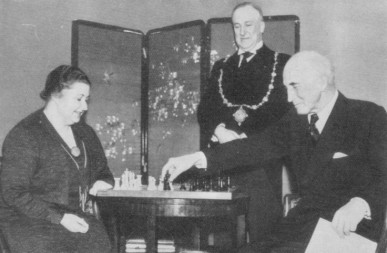
Left to right: Vera Menchik, William Robert Noble (Mayor of Margate) and Sir John Simon
The tournament was won jointly by Fine and Keres, ahead of Alekhine. Referring to the above speech, Fine wrote on page 53 of The Psychology of the Chess Player:
‘Alekhine even went to incredible lengths to avoid any mention of Capablanca’s name. In 1937, at a chess tournament in Margate, England, Sir John Simon, then Home Secretary, made some opening remarks. What he said was of no particular consequence, but he happened to mention Capablanca’s name in passing. Alekhine immediately got up and ostentatiously left the room. The enemy must be completely exterminated, and even his name must disappear.’
Whether Alekhine was indeed annoyed by the mere mention of Capablanca, as opposed to Sir John Simon’s comment about Alekhine’s play in Buenos Aires, is, of course, unknowable.
Later the same year CHESS published this game:
Sir John Simon – B. Fairburn
National Liberal Club v London University match, London, 1937
Queen’s Gambit Declined
1 d4 d5 2 c4 e6 3 Nc3 Nf6 4 Bg5 c6 5 Nf3 Nbd7 6 cxd5 exd5 7 e3 Bd6 8 Rc1 O-O 9 Bd3 Qc7 10 O-O Re8 11 Nb5 Qb8 12 Nxd6 Qxd6 13 Bf4 Qe7 14 Qc2 Ne4 15 h3 h6 16 Rfe1 Ndf6 17 a3 Nh5 18 Ne5 g5 19 Bh2 f5 20 Qe2 Ng7 21 f3 Nf6 22 Qc2 Nd7 23 Bxf5 Nxe5 24 Bh7+ Kf8 25 Bxe5 Qe6 26 Qc5+ Kf7 27 Bd3 Bd7 28 e4 Rec8 29 exd5 cxd5 30 Bc7 Rxc7 31 Qxc7 Rc8 32 Rxe6 Rxc7 33 Rxc7 Kxe6 34 Rxb7 Resigns.
Source: CHESS, 14 December 1937, page 141.
Under the heading ‘Sir John Simon’, page 116 of the same issue had the following feature:
‘Elsewhere in this issue we give the score of a game recently played by Britain’s Chancellor of the Exchequer. All chess players will remember with pleasure his brilliant opening of last year’s [sic] Margate congress.
Deputizing for Sir John at the Sheffield Cutlers’ Feast recently, Dr Burgin, Minister of Transport, referred to the Chancellor’s partiality to chess and added, “Of chess it has been said that life is not long enough for it – but that is the fault of life, not of chess”. […]’
In passing, it may be noted that this quote has often been attributed to Irving Chernev, who gave it (without attribution) on page 108 of The Bright Side of Chess (Philadelphia, 1948). Moreover, the ‘cold bath for the mind’ quote given above is sometimes erroneously stated to have originated with Sir John Simon himself, rather than with Law.
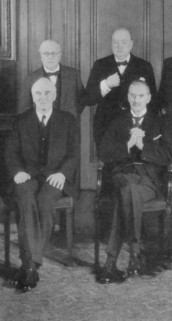
Four members of the Chamberlain
war cabinet (September 1939-March 1940)
Seated: Sir John Simon and Neville Chamberlain. Standing: Sir
Kingsley Wood and Winston Churchill
The final game is a hard-fought battle from a 14-board simultaneous display (+12 –0 =2) against a prodigy nearly 60 years his junior:
Arturo Pomar – Viscount Simon
National Liberal Club, London, January, 1946
Queen’s Gambit Declined
1 d4 Nf6 2 c4 e6 3 Nc3 d5 4 Bg5 Be7 5 e3 Nbd7 6 Nf3 O-O 7 Rc1 c6 8 a3 Ne4 9 Bxe7 Qxe7 10 Bd3 f5 11 cxd5 cxd5 12 O-O a6 13 Ne5 Nxe5 14 dxe5 b5 15 Bxe4 dxe4 16 Ne2 Bb7 17 Nd4 Rad8 18 Rc3 Rd5 19 Qc2 Rd7 20 Rc1 Bd5 21 h3 Bc4 22 b3 Bd3 23 Qb2 f4

24 exf4 Rxd4 25 Rc6 Rd7 26 Rxa6 Rxf4 27 Rcc6 b4 28 Rxe6 bxa3 29 Qc1 Qh4 30 g3 Qxh3 31 Qxf4 Qf1+ 32 Kh2 h6 33 Ra8+ Kh7 34 Qf5+ Resigns.
Source: BCM, March 1946, page 90.
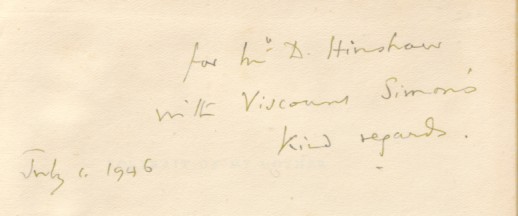
An inscription by Viscount Simon in our copy of his book Portrait of My Mother
Even later, he was still in demand as a chess VIP. For example, on page 96 of the February 1950 CHESS R.G. Wade included the following in his report of the Hastings, 1949-50 tournament:
‘A clear symbol of the new drive appearing in British chess was the choice of Viscount Simon (concerning whom Hastings M.P. Cooper-Key remarked, “rather be a very good chessplayer than one of the foremost Lord Chancellors of England”) to open the congress. Confessing his “immense devotion to this magnificent game”, Lord Simon described chess as the epitome of life, as unpredictable as the weather but as inevitable as fate. “The game was aristocratic and democratic … the same rules worked on both sides of the ‘iron curtain’ … chess was very important as a link between all peoples.” Lord Simon’s acquaintance with chess is not casual. He has played for the National Liberal Club; mentioned how he once visited the Indian Palace where the Emperor Akbar used to play living chess and attended that memorable event, the Alekhine-Capablanca match in Buenos Aires in 1927.
It was quite amusing after the speeches to watch this distinguished visitor repeatedly declining officials’ suggestions to go to another room for tea. He had come down to Hastings for chess and he remained watching the games until he had to leave to catch the last train.’
Tony Gillam (Nottingham, England) sends this cutting from page 11 of the Times of India, 13 February 1928:
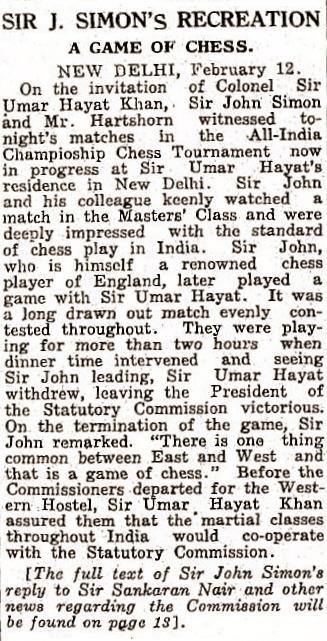
Sir John Simon discussed his work as Chairman of the Indian Commission on pages 144-156 of his memoirs Retrospect (London, 1952).
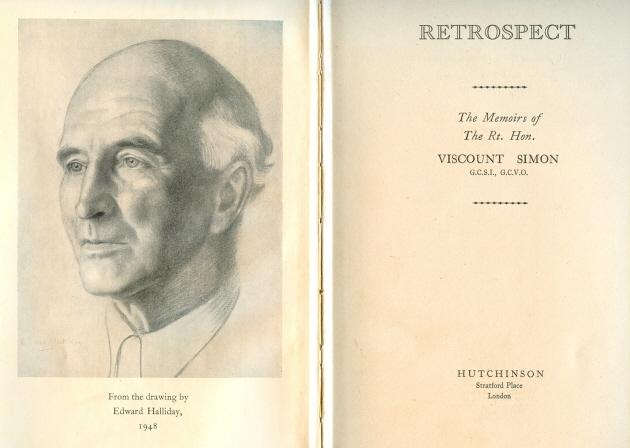
(6252)
Olimpiu G. Urcan (Singapore) has submitted this photograph from
page 264 of the Illustrated London News, 20 August 1932:
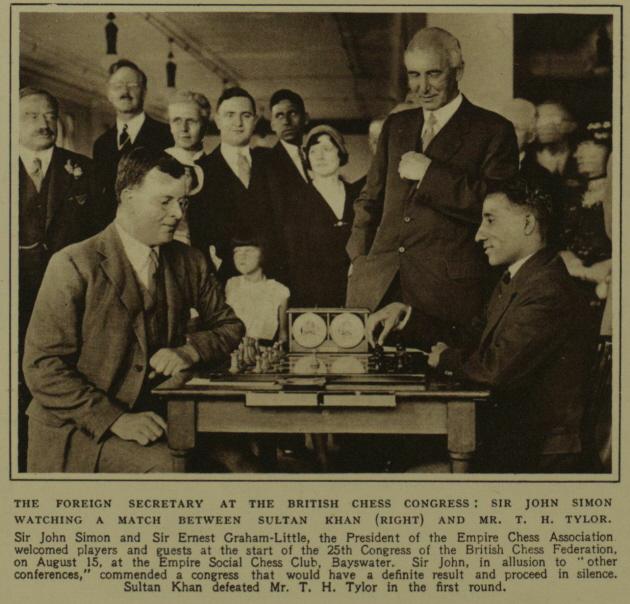
(7490)
From Alan Smith (Stockport, England)
Sir John Simon – G.M. Thomas
Reform Club v Queen’s Club, 1929
Queen’s Gambit Declined
1 d4 d5 2 c4 e6 3 Nc3 Nf6 4 Bg5 Nbd7 5 Nf3 Be7 6 e3 O-O 7 cxd5 exd5 8 Bd3 b6 9 O-O Bb7 10 Rc1 c5 11 Bb1 Rc8 12 Bxf6 Nxf6 13 Ne5 Re8 14 Qc2 Bd6
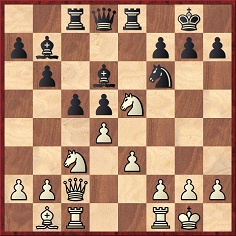
15 Ng4 cxd4 16 exd4 Nxg4 17 Qh7+ Kf8 18 Qh8+ Ke7 19 Rfe1+ Kd7 20 Bf5+ Kc7 21 Nb5+ Kb8 22 Rxc8+ Bxc8 23 Rxe8 Qg5 24 Rxc8+ Kb7 25 Nxd6+ Resigns.
Source: Times Literary Supplement, 28 November 1929, page 1007:
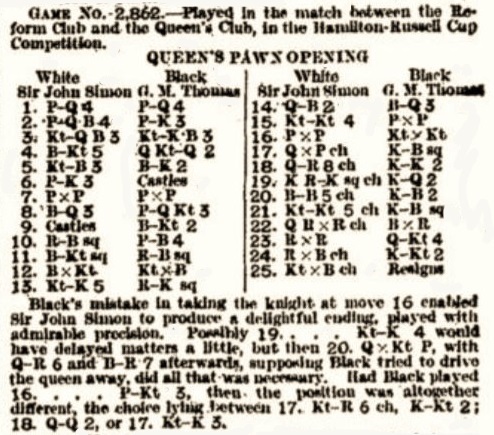
Sir John Simon – Morley Roberts
Reform Club v Authors’ Club, December 1933
Albin Counter-Gambit
1 d4 d5 2 c4 e5 3 dxe5 d4 4 Nf3 Nc6 5 a3 Be6 6 Qc2 Bc5 7 b4 d3 8 exd3 Bd4 9 Bb2 Bxb2 10 Qxb2 Nge7 11 d4 Bg4 12 d5 Nxd5 13 cxd5 Qxd5 14 Nc3 Qe6 15 Nb5 Rc8 16 Be2 Bxf3 17 Bxf3 Nxe5 18 O-O Nxf3+ 19 gxf3 O-O 20 Kh1 Qh3 21 Rg1 Qxf3+ 22 Rg2 g6 23 Nd4 Qd5 24 Re1 c5 25 bxc5 Rxc5 26 f3 Rc4 27 Re4 Rd8 28 Rd2 Qh5
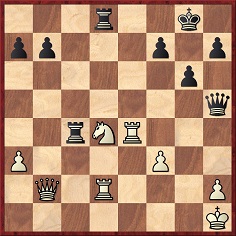
29 Re3 Rdc8 30 Nb3 Qb5 31 Red3 Qe8 32 Re2 Qc6 33 Kg2 Rg4+ 34 Kf2 Rh4 35 Ke1 Qb6 36 Rde3 Rf8 37 Qc3 h6 38 Kf1 Qb5 39 Nd4 Qd5 40 Re4 Rh5 41 Re8 Rxe8 42 Rxe8+ Kh7 and White wins.
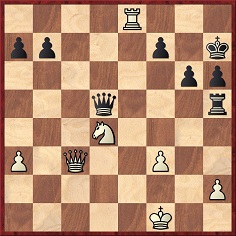
Source: The Times, 11 December 1933, page 18:
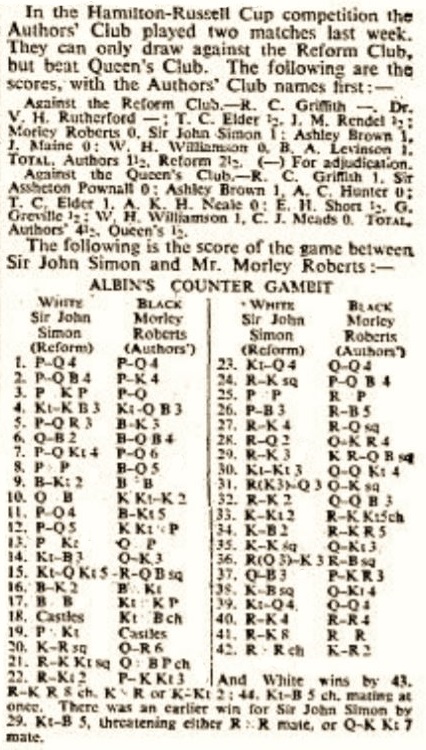
Alan Smith also notes that the game against Fairburn in our feature article on Sir John Simon was played on 19 November 1937, a report being published in The Times, 23 November 1937, page 19.
(10801)
Gerald Abrahams discussed Andrew Bonar Law, William Watson Rutherford, John Simon and Richard Barnett on pages 37-38 of Not Only Chess (London, 1974):
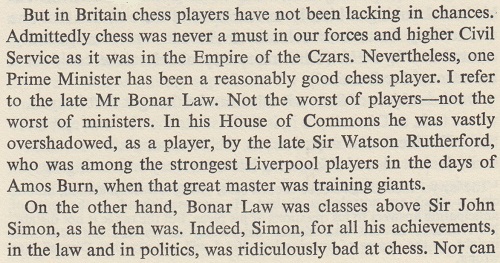
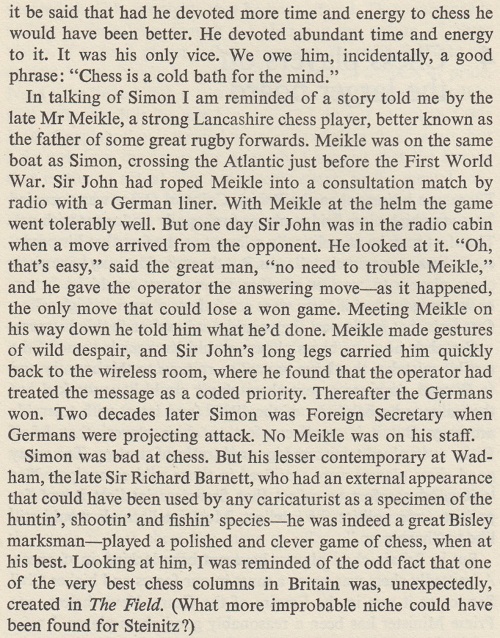
From our feature article Chess Photographs in the Daily Mirror:
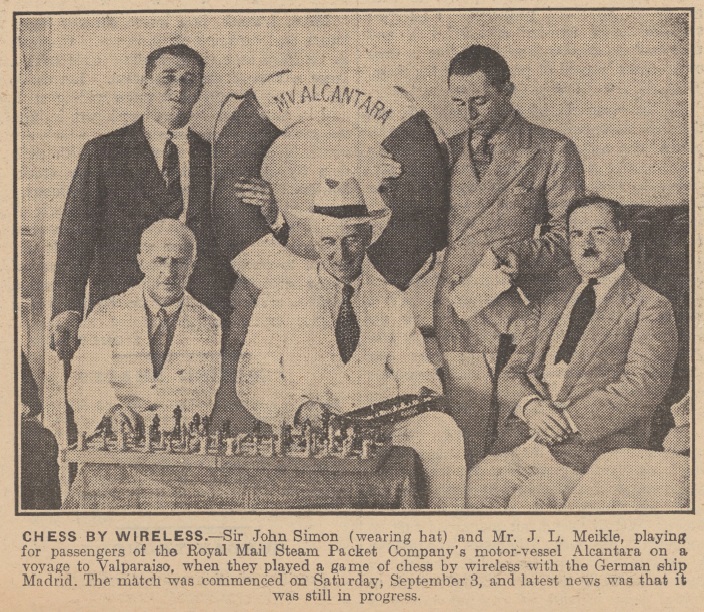
2 October 1927, page 7
We are authorized to reproduce from the Ullstein Bild archive two photographs of Sir John Simon (and Anthony Eden) with Adolf Hitler, in Berlin, March 1935:
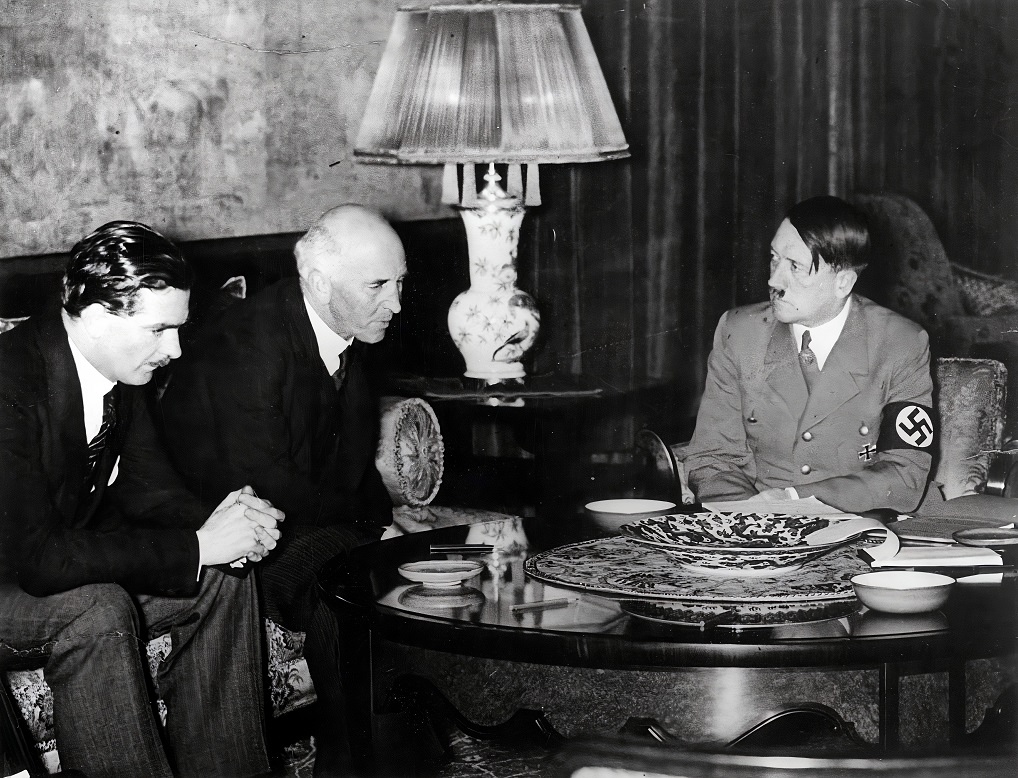
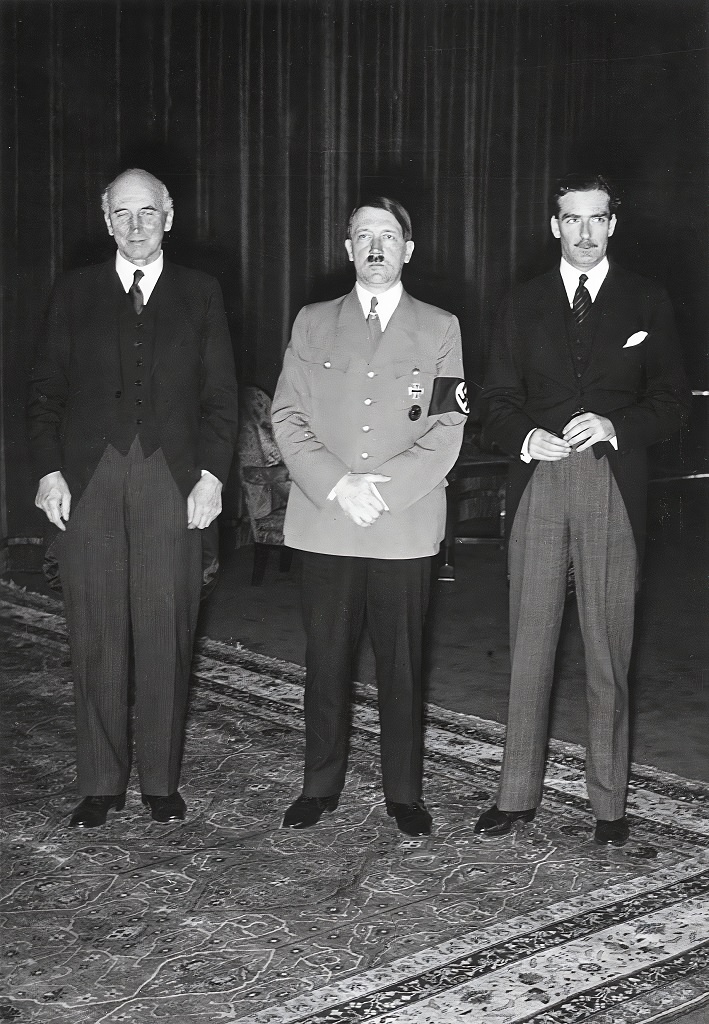
To the Chess Notes main page.
To the Archives for other feature articles.
Copyright: Edward Winter. All rights reserved.